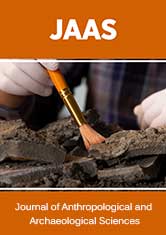
Lupine Publishers Group
Lupine Publishers
Menu
ISSN: 2690-5752
Opinion Article(ISSN: 2690-5752) 
Critiquing Liminality as Model: Exceptions, Cultural Differences, Philosophical Concerns Volume 9 - Issue 4
Timothy L Carson*
Professor of Religious Studies, The Honors College of the University of Missouri, USA
Received: June 25, 2024; Published: July 09, 2024
Corresponding author: Professor of Religious Studies, The Honors College of the University of Missouri, USA
DOI: 10.32474/JAAS.2024.09.000320
Introduction
Liminality can be defined as dwelling in an in-between space and time, which characterizes most transitions. Those who pass through it either voluntarily or involuntarily have an opportunity to shift focus, recalibrate purpose, and think about, perhaps change, identity. Once powerful thresholds are crossed such as experiencing a natural disaster, choosing to leave one’s profession for another, experiencing trauma, or even graduating from university, individuals and groups enter a time and space of relative chaos, uncertainty, ambiguity, and confusion. Familiar landmarks and signs are missing. Identity is in flux. The way forward is unknown. Thus, the liminal domain is paradoxical; it provides the simultaneous possibility of danger and discovery while navigating the passages of this journey.
Social and individual transitions were first studied by anthropologists who conducted their field research in tribal, pre-industrial, agrarian, highly communal societies that had elaborate ritualized processes to negotiate recurring cycles of change as well as addressing times of sudden disruption and crisis. Arnold van Gennep named this pattern The Rites of Passage [1], and they included practically every meaningful transition through which people normally pass. Van Gennep came to believe that the energy found in systems eventually dissipates and must eventually be renewed. As the process of renewal is often very disruptive, full of disturbance and chaos, transitional rituals facilitate passage while protecting the group from what might otherwise be emotionally overwhelming.
Rites of passage address practically every developmental, territorial, seasonal, or crisis transition through which individuals or groups may pass. They function by way of ceremonies designed to move individuals and groups from the status quo, through the transitional period of liminality, and into a post-liminal new state of being. Though taking on a multiplicity of forms, the arc of passage retains a recognizable pattern. The tripartite metamodel of separation, liminal domain, and reaggregation becomes highly important, the bedrock of what may be understood as a pan-theoretical model.
This understanding of liminal pattern was refined, expanded, and adapted by the next generation of researchers, the most significant of whom was Victor Turner, who forayed beyond the work of van Gennep by defining the liminal phase of the rites of passage in interstructural terms [2]. Turner opened new doors to a broader comparative liminality in contemporary culture [3]. It was also Turner who coined helpful words for the discipline. One was borrowed from the Latin, “communitas,” a specially bonded community of those who shared the same liminal phenomenon [3], and the other is the notion of “permanent liminality,” [3] which is an intractable liminality, persistent, ongoing, and indefinite. Examples include the aftermath of mass atrocities, extended prison terms, and communities designated to the margins of a society according to status.
This original work within the field of anthropology research and study on liminality, the insights of which were borrowed and adapted by a host of other disciplines, primarily in the humanities and social sciences. This body of knowledge has been woven into the study of therapeutic models, literature, education, organizational leadership, spirituality, gender identity, social reform movements, natural disaster, death and dying, war and its aftermath, leadership development, migration, online digital landscapes, genocides and atrocities, interdisciplinary and global education, cross-cultural adoption, social marginality, disability studies, biomedical ethics, the relationship between the human and more than human world, and the interface between human and artificial intelligence.
These fields have borrowed, as I have claimed elsewhere, a liminal hermeneutical lens through which they might interpret transitional phenomena, and a process model to both identify the unfolding patterns of transition and help others to do the same [4].
Because these liminal eruptions are so very universal to human experience, the applications of liminality have been ubiquitous. This, however, opens the door to questions about application: What are the limits of this model? How have researchers and practitioners over simplified or generalized? How do cultural worldviews reshape the liminality conversation?
Rising Issues Surrounding Liminality as Model
Liminality does not provide a theory of everything. Nothing can. Not every unanswered question is explained through liminal categories. The process of interpreting is highly important, as liminality in and of itself does not guarantee outcomes. As Bjorn Thomassen reminds us, liminality describes phenomena, leaving the hard work to those who have knowledge and agency to create meaningful change [5].
In popular culture the term liminality has been loosely and broadly employed, sometimes incorrectly. In popular culture, liminality has been used to provide an explanation for anything that is strange, odd, outside the norm, paradoxical, vacant, abandoned, or occupying a non-space. By attributing liminality to everything, the term becomes more and more diluted. Turner’s coined word, liminoid, might be a more apt description. In popular culture, especially during and after the pandemic, preoccupation with vacant, abandoned, and bleak landscapes have emerged as significant in the collective imagination. This includes the digital domain with such phenomena as “backrooms” in game platforms. This cultural longing and wondering have led to preoccupation with the nostalgia, wonder, and terror of liminoid spaces.
In addition, as academic disciplines borrow liminal categories in the interest of their own areas, they often shift meanings that change the meaning of the original research. Broadening applications is not in itself an error, but knowing the difference between original meanings and current applications remains important; it may not be liminality they are describing, but something else.
Liminal zones have been understood as spaces when they are actually processes. Paul Stenner has identified several concerns that deserve our consideration [6]. He provides a caution about thinking of liminal zones too spacially rather than in terms of process. We should avoid inclinations to make what is a process into a thing. In our attempts to conceptualize a phenomenon, we often describe phenomena as more concrete and static than they really are. A redefinition of liminal passage could better be expressed as different experiences moving between varying fields.
Cultural context remains a very important aspect of our analysis. We need to remain aware of cultural context; what liminality means in one context may not have an equivalent meaning in another.
Are liminal concepts and assumptions transcultural and universal? Do they translate when crossing the borders of diverse cultural thought and practice? Some patterns seem universal, but universal to whom? Cultural differences will inevitably shape the way we define and understand varieties of liminalities and sometimes represent a tension with claims of rites of passage universality.
One example is the difference a Buddhist worldview might make in interpreting what we have called liminal thresholds and reality. If the world of sense is non-permanent and transitory, then phenomena such as crossing thresholds receive a different interpretation. If that sensory world is located within a world of limitless openness, “a hollow-space of no-meaning that is without limits,” then liminality becomes a contradiction in terms; everything is liminal and everything is not [7].
An obvious question arises: Can we speak of Turner’s understanding of “Permanent Liminality” when in Buddhist philosophy everything is cast within a background of impermanence?
Conclusion
Liminality continues to provide a helpful model in the analysis of change and transition in natural, social, academic, and professional contexts. It does not provide the answer to everything, has often been applied loosely to describe phenomena, is more fluid than often described, and is highly shaped by cultural context. Nevertheless, liminal studies remain a helpful body of knowledge in the interpretation of transition and change for individuals, communities, and natural processes in the world.
References
- Van Gennep, Arnold (1960) The Rites of Passage. London: Routledge & Kegan Paul.
- Turner Victor (1967) Betwixt and Between: The Liminal Period in the Rites of Passage,” in The Forest of Symbols. Ithaca: Cornell University Press.
- Turner Victor (1969) The Ritual Process: Structure and Anti-Structure. New York: Aldine Publishing Company.
- Carson Timothy, Rosy Fairhurst, Nigel Rooms, Lisa Withrow (2021) Crossing Thresholds: A Practical Theology of Liminality. Cambridge, U.K.: The Lutterworth Press.
- Thomassen Bjorn (2018) Liminality and the Modern: Living Through the In-Between. New York: Routledge.
- Stenner Paul (2021) Experience on the Edge: Theorizing Liminality, in Theory and History in the Human and Social Sciences, Wagoner and Zittoun, eds.
- Ota Hironobu (2022) Twofold Being-in-the-World in Ueda’s Philosophy – On His Interpretation of Heidegger and Nishida in Tetsugaku Companion to Ueda Shizuteru, Ed. Ralf Muller, Raquel Bouso and Adam Loughnane.

Top Editors
-

Mark E Smith
Bio chemistry
University of Texas Medical Branch, USA -

Lawrence A Presley
Department of Criminal Justice
Liberty University, USA -

Thomas W Miller
Department of Psychiatry
University of Kentucky, USA -

Gjumrakch Aliev
Department of Medicine
Gally International Biomedical Research & Consulting LLC, USA -

Christopher Bryant
Department of Urbanisation and Agricultural
Montreal university, USA -

Robert William Frare
Oral & Maxillofacial Pathology
New York University, USA -

Rudolph Modesto Navari
Gastroenterology and Hepatology
University of Alabama, UK -

Andrew Hague
Department of Medicine
Universities of Bradford, UK -

George Gregory Buttigieg
Maltese College of Obstetrics and Gynaecology, Europe -

Chen-Hsiung Yeh
Oncology
Circulogene Theranostics, England -
.png)
Emilio Bucio-Carrillo
Radiation Chemistry
National University of Mexico, USA -
.jpg)
Casey J Grenier
Analytical Chemistry
Wentworth Institute of Technology, USA -
Hany Atalah
Minimally Invasive Surgery
Mercer University school of Medicine, USA -

Abu-Hussein Muhamad
Pediatric Dentistry
University of Athens , Greece

The annual scholar awards from Lupine Publishers honor a selected number Read More...




